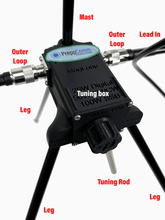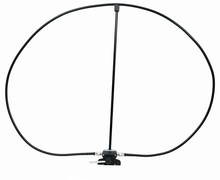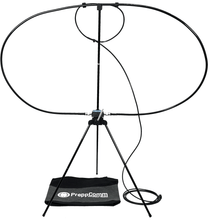
PreppComm α Magnetic Loop
This 1.5 lb. VHF, UHF, HF Alpha PREPPCOMM α MagLoop includes a nine foot feed line with low loss BNC connector, plus built-in and removable two-piece tripod legs, making this the perfect POTA, SOTA, home, or portable antenna for tabletop, desktop, park bench, and or deployment on the floor or ground.
Specifications
• Tunable from 7 MHz to 21.450 MHz plus 2 Meters and 440MHz.
• Rated at 100W PEP SSB, 50W CW, or 25W digital.
• IP Rating is IP-53: Protected against dust limited ingress, no harmful deposits. Protected against direct sprays of water up to 60 degrees from the vertical.
• Environmental operating parameters: -15 to 130 degrees Fahrenheit and winds up to 25 Mph before needing additional weight.
• Weight: 24 Ounces, 1.5 lbs. or 0.68 Kg.
Included
1 – 25 inch mast in two pieces that couple together,
3 – 22-inch tripod leges in two pieces that couple together,
1 – Tuning box with 3 built-in female tripod leg inserts and 1 female 5/8 11 tripod mount,
1 – Fine tuning fulcrum rod,
1 – BNC Female to UHF PL259 Male adapter,
1 - BNC Female to SMA male to mate with the SMA type cable connectors
1 – Outer LMR400 heavy duty coax loop,
1 – Inner shielded faraday loop with a 9' feed line and BNC connector, and
1 – PreppComm zippered Field Bag.
This antenna is truly a breakthrough - the size and weight for portability is truly a step forward from portable magnetic loops of the past, and the built-in tuner uses a unique; and easy to use tuning system. Construction is top quality to ensure long life in both wet and dry climates.
The antenna can be operated indoors or outdoors, however better results will be attained outdoors. For best results indoors, operate near a window that faces the direction you wish to transmit toward. Focus is on the rim, not through the center, as most suppose! The antenna is 20" in diameter.
Materials Used
Isn’t it obvious why the price is high when you see the following materials used in the construction of the PREPPCOMM α MagLoop antenna?
Gold, Solder, Ceramic, Aluminum, Stainless steel, Marine shrink tubing, Times Microwave LMR400, and Carbon Fiber infused polymers.
This Magnetic Loop is a great companion to your MMX, DMX-40, or MMX Nomad because it is just as fast, if not faster, to set up and take down as the NO TUNE End Fed antenna, is more compact and easy to aim, not fixed in direction like the End Fed, and can be even operated indoors. However, you do lose some signal strength from the smaller size compared to the long wire End Fed antenna.
Assembly
1. Assemble the mast and insert into the tuning unit (photo 3)
2. Uncoil the LMR400 outer loop, and carefully determine the center. Attach the center to the top of the mast by pressing into the slot, and form the LMR400 into a loop.
3. Plug the PL239 connectors into the tuning unit, and tighten. Hold the LMR400 in position so the connector can be tightened all the way in.
4. Now you should have something looking like photo 4.
5. Place the inner loop top into the slot at the top of the mast, centered.
6. Attach the small inner loop via the two clips to the outer loop, as shown in photo 5.
7. Put the three legs together, and push the top end into the angled holes provided in the underside of the tuning unit. Note: the two pieces are held together by the weight of the antenna above, so during assembly you have to make sure you provide support so they don't separate.
8. Now you have a complete Magnetic Loop, as shown in photo 6. Connect to the transceiver.
Tuning the Antenna
For UHF/VHF, tuning is by adjusting the spacing on the clips holding the inner loop to the outer loop. For HF, the tuning rod (see photo 2) is used. Slowly turn the rod, looking for the place where the background noise in your receiver gets much louder. Note this position of the rod: this position is for the band you are using, so you can move to this position quickly the next time. Now, carefully adjust for maximum noise in the receiver. If you have a tuning mode, or an SWR meter, after you have found the maximum background noise point, you can then turn on the transmitter in a low power mode, and make finer adjustments with the tuning rod via lower SWR.
Specifications, prices, and descriptions are subject to change without notice.














 PreppComm Magnetic Loop Antenna
PreppComm Magnetic Loop Antenna